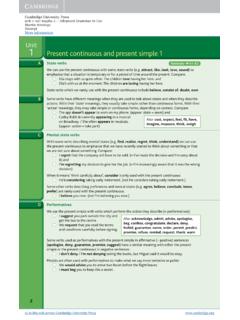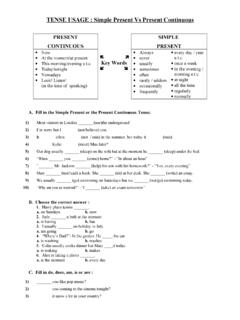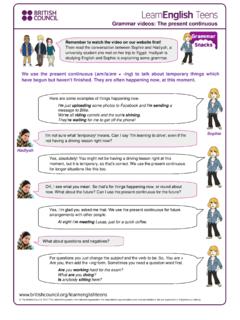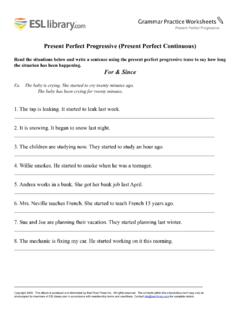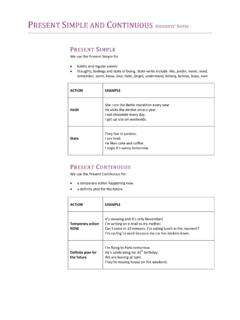Transcription of 1.1 The Simple Present and the Present Continuous
1 The Simple Present and the Present Continuous The Simple Present The Present Continuous Affirmative Statements Affirmative Statements VERB or SUBJECT SUBJECT + BE VERB + ing VERB + -S/-ES. I work I'm She usually works on weekends. She's working right now. They work They're Negative Statements Negative Statements SUBJECT DO/DOES + NOT VERB SUBJECT + BE + NOT VERB + ing I don't I'm not She doesn't sleep enough. She's not / She isn't sleeping well. They don't They're not / They aren't Yes/No Questions Yes/No Questions DO/DOES SUBJECT VERB BE SUBJECT VERB + ing Do you Are you Does she work on weekends?
2 Is she working now? Do they Are they Short Answers Short Answers AFFIRMATIVE NEGATIVE AFFIRMATIVE NEGATIVE. I do. I don't. I am. I'm not. Yes, she does. No, she doesn't. Yes, she is. No, she's not. / she isn't. they do. they don't. they are. they're not. / they aren't. Oxford University Press. Permission granted to reproduce for classroom use. 1. The Simple Present The Present Continuous Information Questions Information Questions WH- WH- DO/DOES SUBJECT VERB be SUBJECT VERB + ing WORD WORD. Why do you work late? Why are you working late?
3 Where does she live? Where is she living? What do they think? What are they thinking? WH- VERB + WH- is VERB + -S/-ES. WORD -S/-ES WORD. Who works late? Who working late? is What happens now? What happening? The Simple Present Affirmative statements can use do or does, but only for emphasis. You're wrong. I do like her. See and for spelling and pronunciation rules for verbs ending in -s and -es. See for contractions with do. The Present Continuous To combine Present Continuous sentences with and, use the subject and am/is/are only once.
4 You're sitting at your desk and going through paperwork. Is not /are not can be used instead of the contracted form for emphasis in negative short answers. No, he is not. No, they are not. Stative verbs (verbs that do not express actions) are not usually used with the Present Continuous . The Simple Present is used instead. I own a house. x I'm owning a house. (incorrect). See for spelling rules for verbs ending in -ing. See for contractions with be. Oxford University Press. Permission granted to reproduce for classroom use. 2.

